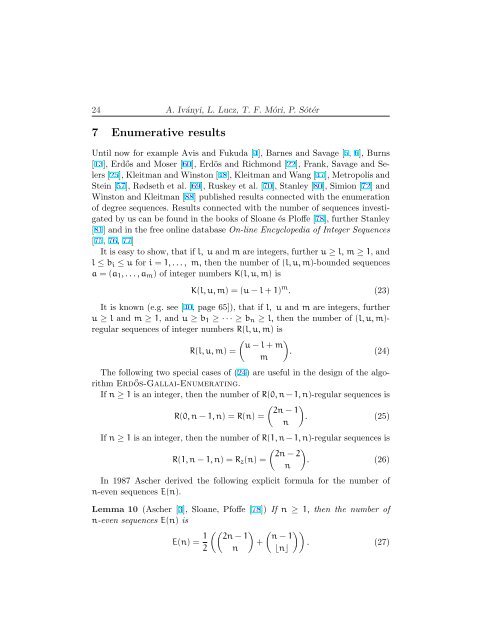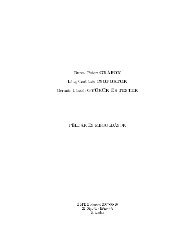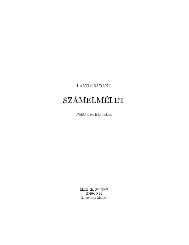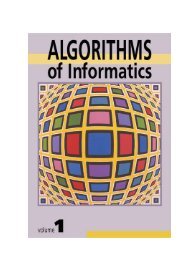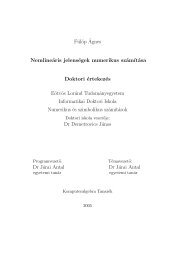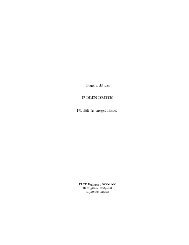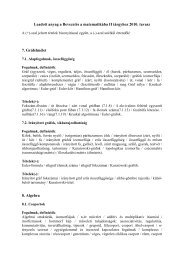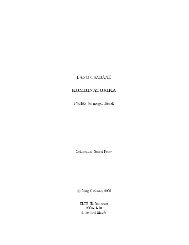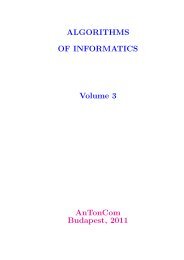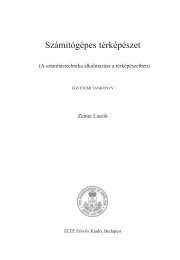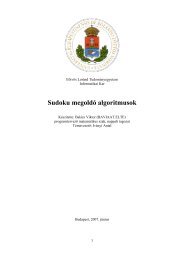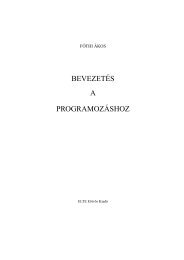On Erd˝os-Gallai and Havel-Hakimi algorithms
On Erd˝os-Gallai and Havel-Hakimi algorithms
On Erd˝os-Gallai and Havel-Hakimi algorithms
Create successful ePaper yourself
Turn your PDF publications into a flip-book with our unique Google optimized e-Paper software.
24 A. Iványi, L. Lucz, T. F. Móri, P. Sótér<br />
7 Enumerative results<br />
Until now for example Avis <strong>and</strong> Fukuda [4], Barnes <strong>and</strong> Savage [5, 6], Burns<br />
[13], Erdős <strong>and</strong> Moser [60], Erdös <strong>and</strong> Richmond [22], Frank, Savage <strong>and</strong> Selers<br />
[25], Kleitman <strong>and</strong> Winston [48], Kleitman <strong>and</strong> Wang [47], Metropolis <strong>and</strong><br />
Stein [57], Rødseth et al. [69], Ruskey et al. [70], Stanley [80], Simion [72] <strong>and</strong><br />
Winston <strong>and</strong> Kleitman [88] published results connected with the enumeration<br />
of degree sequences. Results connected with the number of sequences investigated<br />
by us can be found in the books of Sloane és Ploffe [78], further Stanley<br />
[81] <strong>and</strong> in the free online database <strong>On</strong>-line Encyclopedia of Integer Sequences<br />
[75, 76, 77]<br />
It is easy to show, that if l, u <strong>and</strong> m are integers, further u ≥ l, m ≥ 1, <strong>and</strong><br />
l ≤ bi ≤ u for i = 1, . . . , m, then the number of (l, u, m)-bounded sequences<br />
a = (a1, . . . , am) of integer numbers K(l, u, m) is<br />
K(l, u, m) = (u − l + 1) m . (23)<br />
It is known (e.g. see [40, page 65]), that if l, u <strong>and</strong> m are integers, further<br />
u ≥ l <strong>and</strong> m ≥ 1, <strong>and</strong> u ≥ b1 ≥ · · · ≥ bn ≥ l, then the number of (l, u, m)regular<br />
sequences of integer numbers R(l, u, m) is<br />
<br />
u − l + m<br />
R(l, u, m) =<br />
. (24)<br />
m<br />
The following two special cases of (24) are useful in the design of the algorithm<br />
Erdős-<strong>Gallai</strong>-Enumerating.<br />
If n ≥ 1 is an integer, then the number of R(0, n − 1, n)-regular sequences is<br />
<br />
2n − 1<br />
R(0, n − 1, n) = R(n) = . (25)<br />
n<br />
If n ≥ 1 is an integer, then the number of R(1, n − 1, n)-regular sequences is<br />
<br />
2n − 2<br />
R(1, n − 1, n) = Rz(n) = . (26)<br />
n<br />
In 1987 Ascher derived the following explicit formula for the number of<br />
n-even sequences E(n).<br />
Lemma 10 (Ascher [3], Sloane, Pfoffe [78]) If n ≥ 1, then the number of<br />
n-even sequences E(n) is<br />
E(n) = 1<br />
<br />
2n − 1 n − 1<br />
+ . (27)<br />
2 n ⌊n⌋


